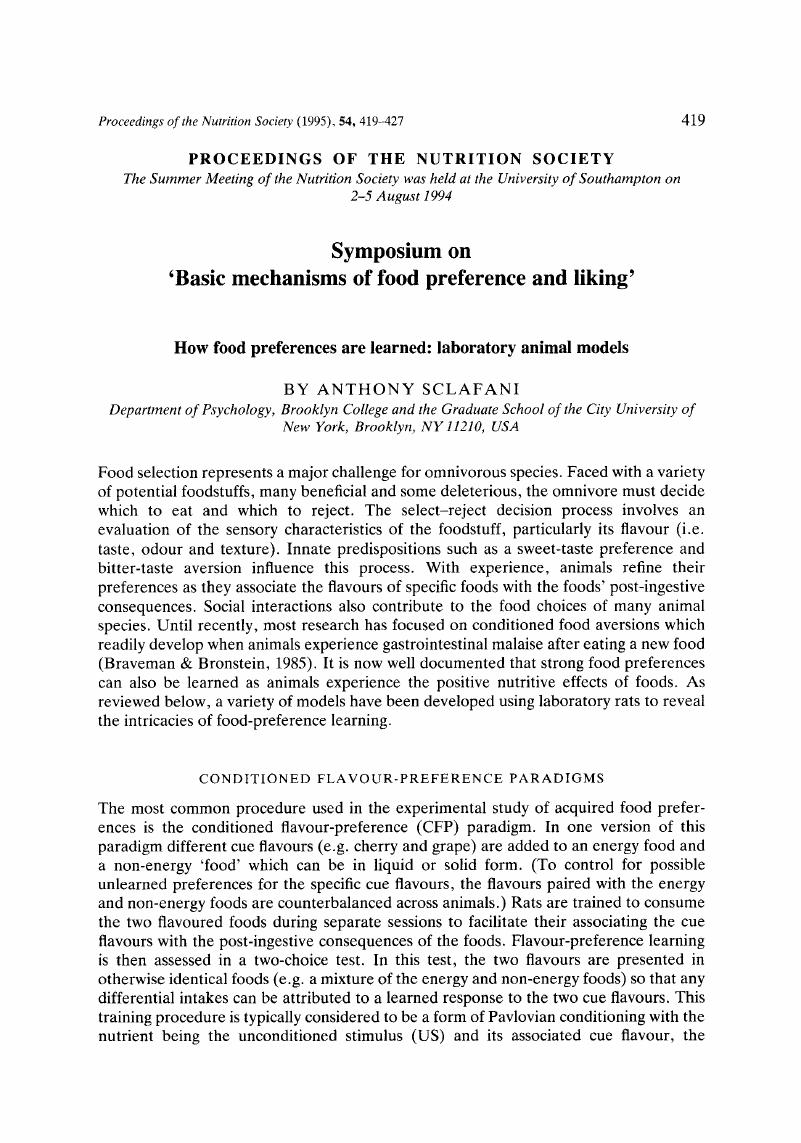Crossref Citations
This article has been cited by the following publications. This list is generated based on data provided by Crossref.
Lucas, François
Azzara, Anthony V
and
Sclafani, Anthony
1997.
Flavor Preferences Conditioned by Intragastric Polycose in Rats: More Concentrated Polycose Is Not Always More Reinforcing.
Physiology & Behavior,
Vol. 63,
Issue. 1,
p.
7.
SCLAFANI, ANTHONY
1997.
Learned Controls of Ingestive Behaviour.
Appetite,
Vol. 29,
Issue. 2,
p.
153.
Reber, Arthur S.
1997.
Implicit ruminations.
Psychonomic Bulletin & Review,
Vol. 4,
Issue. 1,
p.
49.
BIRCH, LEANN L.
and
FISHER, JENNIFER O.
1997.
Food Intake Regulation in Children.
Annals of the New York Academy of Sciences,
Vol. 819,
Issue. 1,
p.
194.
SMITH, BRENDA K.
KELLY, LISA A.
PIÑA, RICARDO
YORK, DAVID A.
and
BRAY, GEORGE A.
1998.
Preferential Fat Intake Increases Adiposity but not Body Weight in Sprague-Dawley Rats.
Appetite,
Vol. 31,
Issue. 2,
p.
127.
FROMENTIN, GILLES
FEURTE, SEBASTIEN
and
NICOLAIDIS, STYLIANOS
1998.
Spatial Cues are Relevant for Learned Preference/Aversion Shifts due to Amino-acid Deficiencies.
Appetite,
Vol. 30,
Issue. 2,
p.
223.
Provenza, Frederick D
Villalba, Juan J
Cheney, Carl D
and
Werner, Scott J
1998.
Self-organization of foraging behaviour: From simplicity to complexity without goals.
Nutrition Research Reviews,
Vol. 11,
Issue. 2,
p.
199.
Kelly, Lisa A
Chavez, Mark
and
Berthoud, Hans-Rudolf
1998.
Transient Overconsumption of Novel Foods by Deafferentated Rats.
Physiology & Behavior,
Vol. 65,
Issue. 4-5,
p.
793.
Ackroff, Karen
and
Sclafani, Anthony
1998.
Conditioned Flavor Preferences: Evaluating Postingestive Reinforcement by Nutrients.
Current Protocols in Neuroscience,
Vol. 5,
Issue. 1,
Birch, Leann L.
and
Fisher, Jennifer O.
1998.
Development of Eating Behaviors Among Children and Adolescents.
Pediatrics,
Vol. 101,
Issue. Supplement_2,
p.
539.
Markison, Stacy
Gietzen, Dorothy W.
and
Spector, Alan C.
1999.
Essential Amino Acid Deficiency Enhances Long-Term Intake but Not Short-Term Licking of the Required Nutrient.
The Journal of Nutrition,
Vol. 129,
Issue. 8,
p.
1604.
Rogers, Peter J.
1999.
Eating habits and appetite control: a psychobiological perspective.
Proceedings of the Nutrition Society,
Vol. 58,
Issue. 1,
p.
59.
Arsenos, G.
and
Kyriazakis, I.
1999.
The continuum between preferences and aversions for flavoured foods in sheep conditioned by administration of casein doses.
Animal Science,
Vol. 68,
Issue. 4,
p.
605.
Ralphs, Michael H.
and
Provenza, Frederick D.
1999.
Conditioned food aversions: principles and practices, with special reference to social facilitation.
Proceedings of the Nutrition Society,
Vol. 58,
Issue. 4,
p.
813.
Sclafani, Anthony
Fanizza, Lawrence J
and
Azzara, Anthony V
1999.
Conditioned Flavor Avoidance, Preference, and Indifference Produced by Intragastric Infusions of Galactose, Glucose, and Fructose in Rats.
Physiology & Behavior,
Vol. 67,
Issue. 2,
p.
227.
Birch, Leann L.
1999.
DEVELOPMENT OF FOOD PREFERENCES.
Annual Review of Nutrition,
Vol. 19,
Issue. 1,
p.
41.
Yu, Wei-Zhen
Sclafani, Anthony
Delamater, Andrew R
and
Bodnar, Richard J
1999.
Pharmacology of Flavor Preference Conditioning in Sham-Feeding Rats.
Pharmacology Biochemistry and Behavior,
Vol. 64,
Issue. 3,
p.
573.
Lucas, François
and
Sclafani, Anthony
1999.
Flavor Preferences Conditioned by High-Fat versus High-Carbohydrate Diets Vary as a Function of Session Length.
Physiology & Behavior,
Vol. 66,
Issue. 3,
p.
389.
Myers, Kevin P
and
Hall, W.G
2000.
Conditioned changes in appetitive and consummatory responses to flavors paired with oral or nutrient reinforcement among adult rats.
Physiology & Behavior,
Vol. 68,
Issue. 5,
p.
603.
Yu, Wei-Zhen
Silva, Robert M.
Sclafani, Anthony
Delamater, Andrew R.
and
Bodnar, Richard J.
2000.
Role of D1 and D2 dopamine receptors in the acquisition and expression of flavor-preference conditioning in sham-feeding rats.
Pharmacology Biochemistry and Behavior,
Vol. 67,
Issue. 3,
p.
537.



